One-way streets, one-way systems and roads will likely be a part of the driving test if available, although this depends on where the test centre is located.
The driving examiner will want to ensure you cover as many road variations as possible within the 40 minute driving test – one-way systems and streets being no exception. Predominantly this depends on whether one-way systems and streets are close enough to your chosen driving test centre to be incorporated into the driving test routes.
This tutorial explains one-way systems / street rules, how to locate them and how to correctly deal with them whilst joining and whilst driving within them.
One-way street / road
During a driving test, the examiner will not try and trick you into driving up a one-way street in the wrong direction. They may however say something along the lines of ‘take the next available left’ and if the next road on the left is a one-way road with no entry from your direction, you will need to be sure what you are doing. Remain vigilant for all road signs whilst driving and in the case of one-way streets, no left or right turn signs.
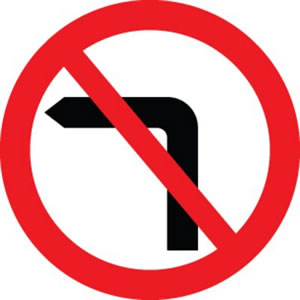
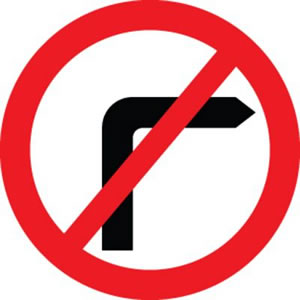
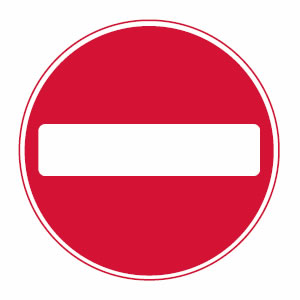
Red circular road signs or circular signs with a red ring indicate a prohibition. A one-way road will usually have a no left or no right turn sign placed a short distance before the junction to inform motorists. On the junction itself, there will be a no entry road sign as illustrated in the images above.
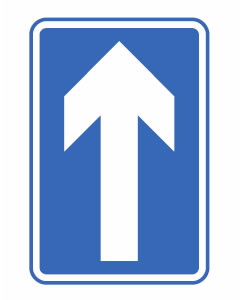
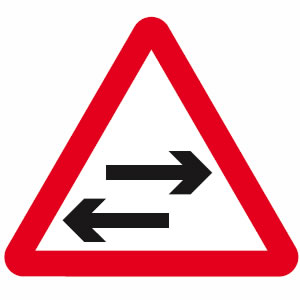
Driving on a one-way street / road
Let’s assume you are now driving on a one-way street in the correct direction. It may not always be too easy to tell if you are on a one-way road, blue rectangular one way traffic signs will be placed at the beginning of the road and at intervals along the way to inform motorists that the road is one way. Road signs will inform you of what happens at the end of the one-way road. Often a one-way road will end, giving way to road with two-way traffic.
Ahead Only Road Sign
You may see an ahead only road sign. Though this looks similar to a one-way traffic sign, it has a very different meaning. For example, you could be at a junction that states ahead only (no turning left / right), but it could be on a two-way street. This is a mandatory sign, where if you were to make a left or right turn, you could be driving into a one-way street, against the flow of traffic.
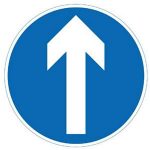
One-way T-junction
One-way T-junctions as illustrated in the diagram often have two lanes that merge into a two-way road. It’s important to select the correct lane. If you are turning right you will need to select the right lane.
If during a driving test you struggle to get into the correct lane due to either leaving it too late or due to high levels of traffic, remain in your current lane.
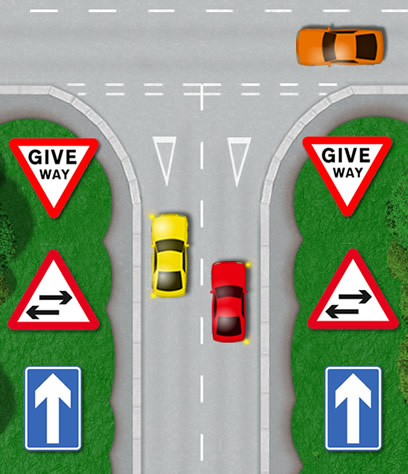
One-way systems
One-way systems can present a confusing challenge to not only learner drivers, but experienced drivers alike. They can often comprise of multiple lanes. During a driving test, the examiner will either tell you which lane they would like you to take, or ask you to ‘follow the signs for’ – leaving it for you to decide which lane is appropriate.
Many driving tests are failed on one-way systems due to learner drivers using the incorrect lane, realising they are in the incorrect lane and accessing the correct lane unsafely. Driving tests are not failed due to using the incorrect lane providing it is legal and safe. If you find yourself in the wrong lane, try and access the correct lane only if it is safe and legal to do so.
You will need to use the Mirror Signal Manoeuvre (MSM) routine and check the blind spot before changing lanes. Check road markings also as solid continuous white lines do not permit crossing. If you cannot access the correct lane, remain in your current lane and the examiner will take you on an alternative route.
One-way road markings
One-way road markings are often placed on one-way roads and systems, especially those with high traffic. They are used as another visual aid alongside signs. Get in lane in good time as leaving it too late may prevent you from gaining access to the correct lane.
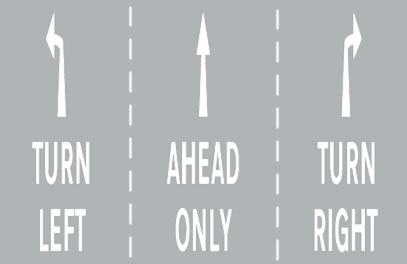
Busy one-way systems
Busy one-way systems will involve a great deal of observation and anticipation and planning. You will need to safely use the correct lanes but you will also need to deal with cyclists and pedestrians. Pedestrian crossings are often located on one-way systems.
Lane straddling
Lane straddling is when a motorist does not keep within the line confines of their own lane. This can be dangerous as it can risk a collision with another vehicle or cyclist if the driver is unaware what they are doing. For further information, see lane straddling.
Lane straddling is often seen at one-way systems, especially at complex systems. Straddling lanes is highly likely to fail a driving test if done either excessively or significantly. See lane discipline for further help.
At one-way systems, junctions and roundabouts, be aware of large vehicles. Large vehicles often need to straddle lanes as they need to extra space for turning. Give large vehicles extra room in such situations.
Overtaking on a one-way road
You are legally permitted to overtake one the left on a one way street.

OK thanks a question, lets say you are driving and come face to face with oncoming car
before you realised you are on a one way what do you do in this situation?
Hi Richard,
Depends on the situation. You will of course need to immediately stop and turn your vehicle around if safe to do so. If it’s not safe to do so, the only option would be to inform the police where they would have to temporarily stop traffic.
What road sign means one way system is it the one with one arrow or the one with two arrows one white and one red
Hello Haroun,
The one-way sign is the blue one with the arrow. The other sign you are referring to, does it have a large white arrow with a smaller red arrow? If so, this is a priority sign.
Hello and thanks alot for your useful website.
what is different between one way road & one way street signs?
Hello Omid,
Do you mean an ahead only sign and a one-way traffic sign? I have updated the page to explain that.
If you are on a one way street and you approach a green light and want to make a left do you have to stop if there is no on coming traffic or can you just make the turn?
Hello Cara,
If you do not have priority, but there are no oncoming vehicles, then you can just make the turn.
Hi,
some streets don’t have signs in my area so is there any other way I could find out if it’s a one way street or not
May I ask a question about how to correctly give Indication/Signal in relation to one way system please? Thank you.
One example – When emerging out of a One-Way Street to a T-junction where traffic light controls are in place. You get in the correct lane to turn left, can you omit the Indication/Signal to the left just because your position shows that the only way you can turn is turning to the left?
Another example – When at a T-junction with sign shows no right turn, you are turning left. If you indicate and signal to the left, is it very wrong?
Hello small bear,
Yes you can omit the signal when in a dedicated lane. However, providing your signal does not cause any confusion, it’s usually best to signal regardless just to ensure other road users know your intent. The same applies to your second example, no need to signal but if you are signaling and providing it doesn’t cause any confusion, then there is not an issue.
Hello ..I want to know
If by mistake you turned into one way:
a. You should reverse back to a minor road.
b. Take a U turn and drive back.
c. Continue till u get a exit.
The DVSA / theory test does of course recommend that you continue to the end of the road, though I would think in reality, most drivers would probably try to turn their vehicle around.
Hi, I have a question about the one way square, which looks very much like a mini roundabout.
1. If I need to turn left at the end of the circle, should I bear left and signal left when approaching the left exit?
2. If I turn right at the end of the circle, should I bear right and signal right before the exit?
Hi prccherry,
It really depends on the situation that you’re currently in and the road layout. If there are dedicated lanes for turning left and one for turning right and you are already in the correct lane for taking the exit that you want, then you do not need to indicate. If you are in the incorrect lane and need to change, then you will need to indicate for the lane change (not the exit). If there are no dedicated lanes, then you should indicate so that other road users know your intentions. Yes, if you’re in a one-way street, you should keep to the side of the road in which your exit is.
if a vehicle pulls out of a driveway onto a one way street somewhere in the middle of the street, so there is no visible signage, and drives the wrong way, and another vehicle accidentally backs into that car as it suddenly appears travelling the wrong way. Which vehicle would be at fault?
Car accidents and driver blame isn’t always quite as obvious as it appears. It may be clear to blame the driver going the wrong way down the street, but if there’s ineffective signage, this might be another cause of blame. There would also be questions as to why the other driver (going the correct way) didn’t manage to avoid the collision. So you see, it can get quite complex.
Are until its vehicles allowed to go down a one way the wrong way
If I drove down a one way road (in which the sign was hidden by a very large overgrown tree) on the left hand side should I have failed my driving test for this as there was a clear road and when I approached the right turn I needed to take I safely moved over signalled and turned ??
Hello Jane,
So if I understand this correctly: I assume this was independent driving and you were following road signs? You entered a one-way road (two lanes) into the left lane. You needed to take a right turn and just before the right turn, you signaled, moved over to the right lane and made the right turn? If that’s the case, then providing you didn’t cause any other drivers to slow down or swerve and you didn’t do anything illegal such as crossing a solid white line for example, then it probably shouldn’t be a test failure particularly if the sign was obscured. Is that the case or do I have it wrong?
DRIVE AS THOUGH IT WERE A 2-WAY STREET; KEEP TO THE RIGHT AND WATCH TRAFFIC AHEAD…. FOR ONCOMING VEHICLES IN THE OTHER OR ONCOMING ONE- WAY LANE. IT IS UP TO YOU TO AVOID THEM. PULL ON TO YOUR FIRST AVAILABLE EXIT.
I saw a car driving the wrong way on a one way road because their car couldn’t get up a steep hill at the end. Is this permissable if done safely or what could be done?
Hi Josh,
I don’t think will be permissible would would be illegal and subject to a fine as it’s potentially dangerous. Their car should be capable of making it up the steep hill and if it isn’t, they should have it looked at.
Do I have to apply the signal indicator as a part of MSM routine in one way road?
If I haven’t to do, and I use the signal indicator will it be a mistake?
Hi Mido
If your car is within a dedicated lane on the one-way road and this dedicated lane takes you onto another route, then no you don’t have to apply an indicator. If the road has lanes and you with to change lane, you would need to indicate. You will also need to indicate if you intend to turn left or right while driving along the one-way road and you’ll also need to indicate at the end on the road if you have the ability to turn left or right. So yes, indicate as normal unless you’re following a dedicated lane.
Generally using a signal unnecessarily is only marked as a minor fault, unless your actions have a detrimental effect on another driver, then it may be marked as a serious.
If you are approaching a one way road and are about 5 metres away from the sign but still in area where traffic coming from both directions are you able to reverse if safe to do so ?
Hi Kris,
If you’re still in the area that has two-way traffic, it’s perfectly legal to reverse, as you say, you need need to ensure it’s safe to do so. You could for example reverse around a corner (a manoeuvre they previously included on most driving tests) to turn the car around.
Hi one quick question: on a one way street(single blue arrow), I reached at the end of the road into a two way street. I failed for my test because I stayed in the left lane( not to the extreme left, but how we normally stay to turn right) and I indicated right as well. There was no designated lanes for left or right in the one way street.( residential area). Was this supposed to be a major driving fault?
Hi Elsa,
I assume this was a test failure due to positioning. Generally, if a test candidate’s poor road positioning has an impact on another road user, then it’s often a test failure. If your positioning didn’t impact on another road user, it does seem a little harsh to fail your test over this, but then, it was only you and the examiner who were there, so difficult to say exactly. Examiners can often be under the impression that a test candidate is unaware of their actions, so I always say that if you do something wrong in the test, say your road positioning is a little off for example, just make the examiner aware that you know you’ve not positioned your car correctly. That way, at least they know you’re aware of your mistake and provided your actions don’t impact on others and you otherwise do everything safely, it can turn a serious fault into a minor.
End of the day, regardless of what the DVSA say about consistency, all examiners are different and what a minor fault may be for one examiner, can be a serious for another.
Just to add to Elsa’s last comment, (i failed my test yesterday), and here’s why.
I was instructed into a one way lane, which was full of parked cars on both sides of the lane (narrow townhouses), i was driving very slowly, in the middle of the lane, as it was quite cramped, observing every car for a potential door opening or a pedestrian crossing between parked cars.
I was instructed to turn right at the end of the road (T junction). When approaching the junction, i did the MSM routine and indicated right, i pulled over to the left side of the road close to the junction (not knowing it was a one way, i was too busy looking at 50 or so cars parked on it) and waited for a safe merging time and turned right when everything was clear.
At the end of the test, the examiner told me i failed because of incorrect positioning (towards the left) on the cramped street. I should have positioned towards the right – so no car behind me could pull up on my right and possibly turn right, when i started turning..
Needless to say, i feel it was very silly to fail because of this. While i was positioned on the left side of the road, there was no way another car could pull up on my right, since there were parked cars all the way upto the T junction; plus i was indicating right, so if they were to start turning when i did, they would have ignored my indication, plus, i would see them on my right and would not start turning…
I acknowledge, if the street was wider, there would have been a possibility of someone pulling up on my right, but this was not the case..
My flaw was that i did not notice it was a one way street, and i should have positioned comfortably in the center of the road..
Is there any advise on what i should have done in such a situation, except for obviously positioning correctly towards the right of the road?
Thank you.
Hello Raman,
The problem here is that if you were unaware what type of road you were on and therefore unaware that you were doing something wrong, then there’s not an awful lot you can do other than pay more attention to road signs.
That aside, if you were to encounter the same issue again and were in the wrong lane, but were aware of this, continue left rather than right (provided of course that the road legally allows this). Going into the wrong lane and taking the wrong direction doesn’t make some examiners too happy but it shouldn’t be a test fail, provided that it’s all done safely. It’s better to do that, rather than to take a potentially hazardous road position. In this situation, talk to the examiner so that they know what’s going on in your mind and that you have the situation under control. You want them to know that you’ve made a mistake in your choice of lanes and that you’re going to take and alternative route. The last thing you want if for them to think that you have no clue what you’re doing. Good luck on your next attempt 🙂
What is the first step you should do before entering in a one way road
Hello Good,
The first step before you do anything in a car is always mirrors.